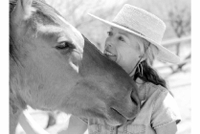By KARYN ZOLDAN

Karen Pomroy is the president and founder of Equine Voices, a nonprofit organization located in Green Valley dedicated to saving Premarin mares and foals. If you’re on Premarin, and you don’t know what’s in the drug… you’ll probably want to read on.
What inspired you to start Equine Voices?
When I lived in California, I helped out at a wild-mustang sanctuary doing nonprofit work. It was there I found out about Premarin mares and foals. I was horrified by what happened to these horses. Since I was approaching 40, I worried about my own need for hormone-replacement therapy. I’ve always wanted to live on a ranch, and I found this property. It wasn’t big enough for wild mustangs, so instead I decided to help Premarin mares and foals, as well as educate women by letting them know where and how the drug was made and how harmful it was.
Interesting.
Before moving here, I found a PMU foal online that was going to slaughter, because Wyeth Pharmaceuticals was cutting contracts. I thought that I could rescue one and bring it to Arizona along with my other two horses. There were seven horses going to slaughter, so I ended up with four. Gulliver, a big, ugly Clydesdale mix, became our mascot.
What’s PMU mean?
Pregnant mares’ urine.
There seems to be a lot of animal abuse in the name of profit. How are the horses used for Premarin?
Premarin, a hormonal prescription drug, is made of estrogens primarily from the urine of impregnated mares. Pregnant mares are forced to stand in small stalls where they cannot lay down, a collection cup attached to their bodies. They are frequently withheld water so their urine will be more concentrated. The gestation period is 11 months. They stand for six to nine months in what is called the pee line. At nine months, they go out to pasture and deliver their babies, which are separated from them at two or three months and sent to slaughter. Ninety-five percent of the babies are sent to slaughter. Stallions roam the pastures impregnating the mares, who then return to the pee line.
How many slaughterhouses are there?
In the United States, there are three foreign-owned slaughterhouses, two in Texas and one in Illinois. All have been operating illegally for 50 years. The locals in these communities have wanted the slaughterhouses to be shut down because of ongoing screams, blood, waste and stench. The slaughterhouse in Illinois was burned down in 2002 and rebuilt in 2004 against the public’s wishes.
Who profits from horse slaughter?
There are big groups like the American Quarter Horse Association and American Veterinary (Medical) Association, who are pro-slaughter. The quarter horse group is a breeding association, and they make their money by breeding horses, as do other horse breeders. We need to pull the reins in and stop the backyard breeding as long as slaughter is available as an out. Auctions profit by slaughter, as kill buyers outbid other bidders and transport horses to slaughterhouses for profit. One reason I think I’m so passionate is that in my heart, I feel that my (childhood) horse was bought by a kill buyer who took it to slaughter when I was 16. And slaughterhouses profit by sending horsemeat to Europe and Japan for gourmet human consumption.
Are there any bills in Congress?
The current bill is HR503, the American Horse Slaughter Prevention Act. If people want to help right now, they should send a letter to their elected officials and ask them to support this bill. Previous bills have died in Congress.
How many horses have you rescued from slaughter?
I have 10 acres of land, and one thing led to another. I thought with this land, I could save more than four horses. I incorporated and chose the name Equine Voices in 2004 and received nonprofit status January 2005. Since then, we have rescued 160 horses.
How do you educate women about Premarin?
Currently, Wyeth Pharmaceuticals has more than 5,000 lawsuits pending. A jury in the Midwest just awarded a woman $3 million because she got breast cancer from taking Prempro (which includes PMU). These drugs have been found to cause breast and ovarian cancer, blood clots and dementia.
How can people get involved?
Aside from coming here and mucking around in the stalls, we need help with fundraising, office work and grant writing. We always need donations. My hay bill is $3,500 a month. Spreading the word is so important. We’re all volunteers, and I’m looking for a program coordinator and youth coordinator.






